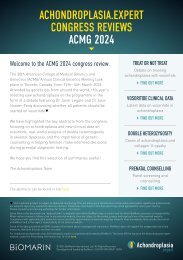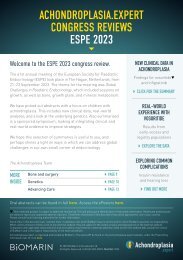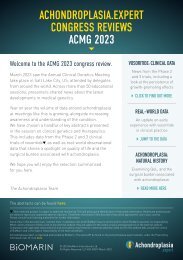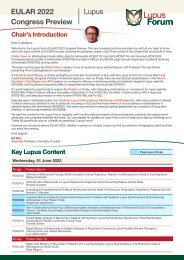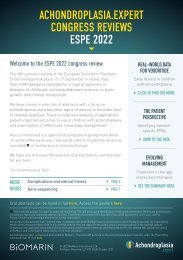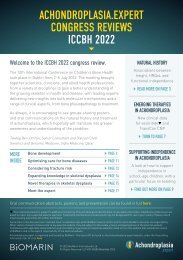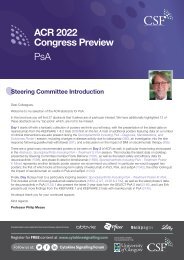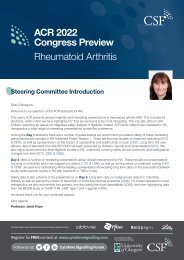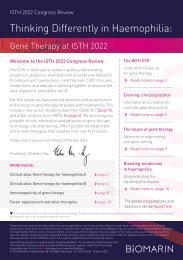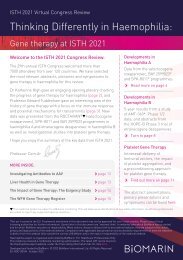EAHAD 2022 Congress Review
You also want an ePaper? Increase the reach of your titles
YUMPU automatically turns print PDFs into web optimized ePapers that Google loves.
<strong>EAHAD</strong> <strong>2022</strong> Virtual <strong>Congress</strong> <strong>Review</strong><br />
Thinking Differently in Haemophilia:<br />
Gene Therapy at <strong>EAHAD</strong> <strong>2022</strong><br />
Welcome to the <strong>EAHAD</strong> <strong>2022</strong> <strong>Congress</strong> <strong>Review</strong>.<br />
The <strong>2022</strong> <strong>EAHAD</strong> <strong>Congress</strong> was once again a virtual event,<br />
welcoming over 2300 attendees from 76 countries, with a<br />
wealth of sessions delivered across four days.<br />
For this review, we have selected abstracts and presentations<br />
from the scientific sessions that are most relevant to<br />
those of us with an interest in gene therapy for people with<br />
haemophilia. This includes GENEr8-1 – with key efficacy<br />
and safety updates [page 2], and HRQoL data shared in an<br />
abstract from O’Mahony et al. [page 2] – plus presentations<br />
on the new 2-year analyses from the HOPE-B trial [page 5].<br />
I hope you enjoy our summary of the key data from<br />
this congress.<br />
Professor Johannes Oldenburg<br />
MORE INSIDE:<br />
Advances in RNA Therapy page 10<br />
Real-World Data page 12<br />
Adherence, Preference, and Satisfaction page 13<br />
Providing Haemophilia Education page 14<br />
The abstracts and poster presentations can be found here<br />
Developments in<br />
Haemophilia A<br />
Data from GENEr8-1,<br />
plus a selection of abstracts<br />
focused on ROCTAVIAN ®<br />
(valoctocogene roxaparvovec),<br />
giroctocogene fitelparvovec,<br />
and emicizumab.<br />
Read more on page 2<br />
Developments in<br />
Haemophilia B<br />
Results from HOPE-B,<br />
and abstracts looking at<br />
etranacogene dezaparvovec<br />
and verbrinacogene<br />
setparvovec.<br />
Read more on page 5<br />
Advances in Gene Therapy<br />
Clinical studies of<br />
recombinant AAV vectors are<br />
ongoing for the treatment<br />
of severe haemophilia.<br />
Read more on page 7<br />
This medicinal product is subject to additional monitoring. This will allow quick identification of new safety information. Healthcare professionals<br />
are asked to report any suspected adverse reactions.<br />
Treatments mentioned in this document may not be approved for use in your country. Please consult local licensing authorities for further<br />
information. Some links in this document are “external links” to websites over which BioMarin has no control and for which BioMarin assumes<br />
no responsibility. When visitors choose to follow a link to any external website, they are subject to the cookie, privacy and legal policies of the<br />
external website. Compliance with applicable data protection and accessibility requirements of external websites linked to from this website<br />
falls outside the control of BioMarin and is the explicit responsibility of the external website.<br />
Haemophilia.expert is organised and funded by BioMarin. For healthcare professionals only. The latest API<br />
can be found on the Haemophilia.expert website, under the Prescribing Information tab. Or click here.<br />
© <strong>2022</strong> BioMarin International Ltd. All Rights Reserved. EU-ROC-00186 October <strong>2022</strong><br />
1
<strong>EAHAD</strong> <strong>2022</strong> Virtual <strong>Congress</strong> <strong>Review</strong><br />
Developments in Haemophilia A<br />
New data were presented in haemophilia A across a range of<br />
treatments, from novel gene therapies to emicizumab. This included<br />
the 2-year data from GENEr8-1.<br />
In an <strong>EAHAD</strong>-supported research session,<br />
Professor Johnny Mahlangu shared the 2-year<br />
analysis looking at the efficacy and safety of<br />
valoctocogene roxaparvovec gene transfer for<br />
severe haemophilia A. ROCTAVIAN ® is indicated<br />
for the treatment of severe haemophilia A in<br />
adult patients without a history of factor VIII<br />
inhibitors and without detectable antibodies<br />
to AAV5. Please read the ROCTAVIAN ® SmPC<br />
before prescribing. An overview of the safety<br />
results from GENEr8-1 was presented,<br />
highlighting that in this 2-year analysis the<br />
most common AE remains ALT elevation,<br />
which was seen in 89% of participants. Overall,<br />
83% received immunosuppression treatment<br />
in response to these elevations, and 53% of<br />
those were off immunosuppression at Week<br />
52, and 99% by Week 104. Other AEs included<br />
headache, arthralgia, nausea, AST elevation,<br />
and fatigue. There were no thrombotic events,<br />
FVIII inhibitors, or non-cutaneous cancers. Four<br />
new SAEs occurred in the last year of the study,<br />
but none were attributed to valoctocogene<br />
roxaparvovec or immunosuppression.<br />
Professor Mahlangu briefly touched on the<br />
FVIII activity by CSA over 3 years for the main<br />
mITT and subset populations, before looking<br />
at the mean ABR results, which suggest gene<br />
therapy with valoctocogene roxaparvovec<br />
is superior to FVIII prophylaxis. The mean<br />
change from baseline was 4.1 treated<br />
bleeds per year, reaching the threshold<br />
for statistical superiority (P
<strong>EAHAD</strong> <strong>2022</strong> Virtual <strong>Congress</strong> <strong>Review</strong><br />
and without history of inhibitors received a<br />
6x10 13 vg/kg infusion. Participants completed<br />
HRQoL questionnaires at baseline and<br />
26 and 52 weeks after gene therapy. Overall,<br />
core outcomes of mental health, pain and<br />
discomfort, and ability to perform daily activities<br />
improved following gene therapy compared<br />
to baseline. Mean baseline Haem-A-QoL<br />
total score was 75.7, which improved above<br />
the clinically important difference to 81.2<br />
and 82.2 at Weeks 26 and 52, respectively<br />
(P
<strong>EAHAD</strong> <strong>2022</strong> Virtual <strong>Congress</strong> <strong>Review</strong><br />
single dose of etranacogene dezaparvovec<br />
resulted in a stable and durable increase<br />
in mean FIX activity into the near-normal<br />
range at 18 months, and gave haemostatic<br />
protection following discontinuation of<br />
prophylactic FIX infusions. [PO143]<br />
Gomez et al. shared multi-year durable<br />
FIX expression data from a Phase 2b study<br />
of etranacogene dezaparvovec demonstrating<br />
proof of concept of disease correction<br />
using the gain-of-function FIX variant in<br />
participants with pre-existing AAV5 NAbs.<br />
Participants in this ongoing open-label,<br />
single-dose, single-arm study (N=3) received<br />
a single intravenous dose (2×10 13 gc/kg).<br />
The primary efficacy endpoint was FIX activity<br />
≥5% 6 weeks after dosing. All participants<br />
discontinued routine FIX prophylaxis, and<br />
FIX activity increased from ≤1% to a mean<br />
of 31% at Week 6, and continued to rise to<br />
an average of 50% at 2.5 years. A sustained<br />
reduction in bleeds and FIX replacement<br />
was demonstrated at 2.5-year follow-up.<br />
FIX consumption<br />
Fix consumption for 54 participants<br />
(IU/year/ participant)<br />
450,000<br />
400,000<br />
350,000<br />
300,000<br />
250,000<br />
200,000<br />
150,000<br />
100,000<br />
50,000<br />
Data are for 54 participants.<br />
0<br />
257,339<br />
12,913<br />
Lead-in 0–6 months 7–12 months<br />
One participant experienced bleeds (one<br />
traumatic, and one spontaneous and mild)<br />
requiring a single dose of FIX replacement.<br />
Two TRAEs resolved without intervention<br />
in one participant, with no new TRAEs over<br />
the last 2 years of follow-up, including no<br />
clinically significant transaminase elevations.<br />
No participant developed inhibitors<br />
to FIX. There was no requirement for<br />
immunosuppression. [PO098]<br />
The study design for B-LIEVE – a Phase<br />
1/2 dose confirmation clinical trial of<br />
verbrinacogene setparvovec (previously<br />
known as FLT180a) for haemophilia B – was<br />
presented by Young et al. The starting dose<br />
for B-LIEVE was selected based on the<br />
results of B-AMAZE and multiple modelling<br />
approaches. In B-AMAZE, FIX activity showed<br />
a dose-dependent response that ranged from<br />
therapeutic levels below the normal range<br />
to FIX levels >150%. Based on this, a dose of<br />
7.7×10 11 vg/kg with a dose cap of 6.93×10 13 vg<br />
was selected for the first patients in<br />
8,399<br />
8,487<br />
13–18 months<br />
p-value
<strong>EAHAD</strong> <strong>2022</strong> Virtual <strong>Congress</strong> <strong>Review</strong><br />
to identify what place gene therapy has in<br />
haemophilia care, now and in the future.<br />
Fletcher et al. presented data from<br />
65 interviews completed to date among<br />
patients, family members, and healthcare<br />
professionals. The results highlight that gene<br />
therapy is a new and potentially life-changing<br />
therapy for people with haemophilia. In<br />
order for its potential to be realised by all<br />
stakeholders, the EXIGENCY group makes<br />
three key recommendations. The first<br />
suggests that patient education around<br />
gene therapy should begin well in advance<br />
of it being offered as a treatment option.<br />
Secondly, psychosocial support should be<br />
built into all stages of the process. And<br />
finally, there is a need for greater integration<br />
between research and clinical care teams to<br />
improve knowledge of gene therapy, and the<br />
impact it might have on any individual who<br />
chooses it as a treatment option. [PO063]<br />
Skinner et al. provided an integrated analysis<br />
of gene therapy outcomes from a systematic<br />
review of published data, and from coreHEM<br />
– a separate initiative to evaluate the efficacy,<br />
safety, comparative effectiveness, and<br />
value of gene therapy. CoreHEM outcomes<br />
were frequency of bleeds, factor activity<br />
level, duration of expression, chronic<br />
pain, healthcare resource utilisation, and<br />
mental health. The value framework was<br />
based around three tiers: health status<br />
achieved/retained, process of recovery, and<br />
sustainability of health. Mapping the value<br />
framework to coreHEM outcomes showed<br />
broad overlap, most prominently in duration<br />
of expression and factor activity level. The<br />
authors noted that a gap analysis identified<br />
several coreHEM outcomes – particularly<br />
patient-reported outcomes of chronic pain<br />
and mental health transformation – where<br />
data collection should be prioritised or<br />
rapidly published to enable a complete<br />
data-driven evaluation of the differentiating<br />
features. [PO066]<br />
Konkle et al. gave an overview of the<br />
WFH gene therapy registry set up and<br />
aims. The primary objective is to determine<br />
long-term safety of FVIII and FIX gene<br />
therapies. Secondary objectives focus on<br />
efficacy and durability, and the long-term<br />
quality of life and burden of disease after<br />
gene therapy infusion. The core data set<br />
also includes information on demographics,<br />
medical history, vector infusion details,<br />
surgeries, and mortality. Data will be<br />
collected at 3, 6, 9, 12, 18, and 24 months<br />
post-infusion, and annually thereafter and<br />
will be captured directly from participating<br />
HTCs or through data linkage with existing<br />
registries. Patient-reported outcomes will<br />
be collected via a mobile application. The<br />
registry will provide the community with a<br />
global tool to collect long-term follow-up<br />
data on people with haemophilia who receive<br />
gene therapy, and will be able to monitor<br />
efficacy as well as known and unknown<br />
safety issues. [PO139]<br />
Dr Paul Batty presented an overview of the<br />
current status of gene therapies, with a focus<br />
on recent efficacy and safety data. To date,<br />
the longest reported follow-up in clinical<br />
studies is 5 years for haemophilia A and<br />
8 years for haemophilia B, with ongoing<br />
FVIII or FIX expression and reduction in<br />
bleeding episodes – although questions<br />
remain surrounding variability in response<br />
and the long-term durability. Although<br />
infusion reactions have been reported<br />
in small numbers, these have generally<br />
been mild. The predominant AE has been<br />
elevations in liver enzymes, some of which<br />
have been assigned to activation of a<br />
cytotoxic T-cell immune response. In view<br />
of the loss of vector expression that has<br />
occurred with this reaction, studies have<br />
incorporated immunosuppressive mitigation<br />
strategies to preserve transgene expression.<br />
Key long-term safety considerations relate<br />
to liver health and whether vector integration<br />
might result in genotoxicity. Currently four<br />
Phase 3 studies are ongoing, and the speaker<br />
expressed the view that licensing approvals<br />
will be seen in the near future for the first<br />
AAV-based approach for haemophilia.<br />
[SP012]<br />
Professor Thierry Vandendriessche’s<br />
abstract focused on the future prospects for<br />
non-AAV gene and cell therapy, addressing<br />
the advantages, limitations, and prospects for<br />
the treatment of patients with haemophilia.<br />
Questions remain about whether the AAVbased<br />
expression will be life-long, and –<br />
since AAV is mostly non-integrating –<br />
FVIII and FIX expression will likely decline<br />
due to dilution of viral genomes in the<br />
face of cell division. This limitation could<br />
be especially important when considering<br />
treating paediatric patients given that<br />
hepatocyte proliferation is even more<br />
pronounced than in adults. This justifies<br />
the use of integrating systems such as<br />
lentiviral vectors to deliver FVIII and FIX<br />
genes into the target cells, allowing stable<br />
expression even upon cell division. Lentiviral<br />
vectors can also be employed in the context<br />
of ex vivo gene therapy for haemophilia<br />
based on gene-modified hematopoietic<br />
stem or progenitor cells. Alternatively, to<br />
achieve targeted integration into predefined<br />
loci, gene editing can be employed based<br />
on CRISPR/Cas. [SP014]<br />
Haemophilia is a rare, life-long disease that<br />
requires comprehensive care. Retrospective<br />
data suggests that comprehensive care<br />
centres can deliver a number of benefits,<br />
including reductions in absence from<br />
school or work, reduced hospitalisation and<br />
mortality, increased self-efficacy, and lower<br />
annual treatment costs. Within a session on<br />
the delivery of care, Professor Ana Boban<br />
gave an update on the accreditation of<br />
haemophilia and gene therapy treatment<br />
centres – an initiative launched in 2013 by<br />
EUHANET, in coordination with <strong>EAHAD</strong><br />
and the EHC. The current accreditation<br />
process is run by <strong>EAHAD</strong>, and centres are<br />
designated as EHCCC or EHTC, based on<br />
evaluation of their ability to provide care<br />
for haemophilia and allied disorders. At<br />
present, there are 159 centres registered<br />
across 34 countries – 117 as EHCCC, and<br />
42 as EHTC. Novel treatment possibilities<br />
improve prophylaxis and provide better<br />
quality of life, but often require increased<br />
medical expertise, patient education,<br />
information exchange, and reorganisation.<br />
Gene therapy calls for a new set of practices,<br />
reassessment of the infrastructure and an<br />
update of current processes in haemophilia<br />
centres. To facilitate these changes, <strong>EAHAD</strong>,<br />
in collaboration with EHC, has taken steps to<br />
define necessary measures for improvement,<br />
build a novel model for implementation of<br />
gene therapy, and provide a new auditing<br />
8 9
<strong>EAHAD</strong> <strong>2022</strong> Virtual <strong>Congress</strong> <strong>Review</strong><br />
and certification protocol. New European<br />
guidelines for the certification of EHTCs<br />
will provide a set of standards, and outline<br />
the specialised services needed to monitor<br />
patients on new treatments. Alongside this,<br />
the on-site auditing process will create a<br />
culture of quality improvement, offering<br />
education to participants and assessing<br />
patient care. EHTCs will form a tight network<br />
through the hub and spoke model, with the<br />
aim to address all aspects of gene therapy<br />
Advances in RNA Therapy<br />
– from dosing and surveillance immediately<br />
post-infusion to long-term follow-up.<br />
Three main gene therapy work streams<br />
will be implemented around supervision,<br />
infusion, and follow-up. The <strong>EAHAD</strong> audit<br />
and accreditation process has a challenging<br />
task to help haemophilia centres to improve<br />
the delivery of care by a multidisciplinary<br />
integrated comprehensive care model and<br />
equal access to all novel therapies, including<br />
gene therapy to all patients. [SP019]<br />
Professor Robert Klamroth presented data from the ATLAS-A/B trial<br />
of fitusiran – an investigational siRNA targeting antithrombin for the<br />
treatment of haemophilia.<br />
Rebalancing haemostasis is the goal of<br />
haemophilia therapy. Factor replacement<br />
is one of the standard approaches, but<br />
non-factor therapies can restore thrombin<br />
generation sufficient to achieve haemostasis<br />
by intervening at different points in the<br />
coagulation cascade. In Phase 1 and 2<br />
studies, monthly SC prophylaxis with<br />
fitusiran resulted in sustained antithrombin<br />
lowering and reduced ABR in people with<br />
haemophilia A or B, regardless of inhibitor<br />
status. ATLAS-A/B was an open-label<br />
Phase 3 study in 120 adult haemophilia<br />
patients without inhibitors.<br />
Fitusiran met the primary efficacy<br />
endpoint, with significant reductions in<br />
treated bleeds for both all treated bleeds<br />
and treated joint bleeds. Subgroup analyses<br />
by haemophilia subtype confirmed the<br />
results, with bleeding rates reduced to<br />
0.0 in haemophilia A, and 2.7 in haemophilia<br />
B. Furthermore, in the fitusiran arm<br />
50.6% of participants had zero bleeds,<br />
and 83.5% experienced three or fewer<br />
bleeding events. Professor Klamroth<br />
noted that the results consistently favoured<br />
fitusiran prophylaxis over on-demand<br />
factor concentrate. Quality of life was<br />
also improved, with clinically meaningful<br />
improvements in both total Haem-A-QoL,<br />
as well as in the key domain of physical<br />
health score. The results seen in ATLAS-A/B<br />
were consistent with those observed in<br />
the ALTAS-INH study, assessing fitusiran<br />
prophylaxis versus on-demand treatment<br />
in haemophilia A or B with inhibitors.<br />
Overall, 78.5% of patients receiving fitusiran<br />
experienced a TEAE, compared to 45.0%<br />
Bleeding events during the efficacy period<br />
Median ABR<br />
35<br />
30<br />
25<br />
20<br />
15<br />
10<br />
5<br />
0<br />
Observed median ABR<br />
for all treated bleeds (IQR)<br />
21.8<br />
(8.4, 41.0)<br />
On Demand<br />
factor concentration<br />
(n=40)<br />
Estimated ABR † reduction 89.9%<br />
(95% Cl, 84.1, 93.6)<br />
(p10) and randomisation era of haemophilia type (A vs B) as fixed effects, and the logarithm of the duration that each<br />
patient spends in the efficacy period matching the bleeding episode being analysed as an offset variable<br />
(P value vs null hypothesis of ratio = 1).<br />
Professor Robert Klamroth<br />
in the on-demand factor concentrate<br />
arm. There were no reports of thrombosis,<br />
and the differences in reported TEAEs of<br />
special interest between the two arms were<br />
consistent with the previously identified<br />
risks of fitusiran.<br />
Professor Klamroth concluded that<br />
fitusiran prophylaxis results in a statistically<br />
Reduced bleeding rate<br />
Median Observed Annualized Bleeding Rate for Treated Joint Bleeds<br />
35<br />
30<br />
25<br />
20<br />
15<br />
10<br />
5<br />
0<br />
Observed median ABR<br />
for treated joint bleeds (IQR)<br />
15.9<br />
(4.2, 33.5)<br />
On Demand<br />
factor concentration<br />
(n=40)<br />
Estimated ABR † reduction 90.3%<br />
(95% Cl, 83.9, 94.1)<br />
(p
<strong>EAHAD</strong> <strong>2022</strong> Virtual <strong>Congress</strong> <strong>Review</strong><br />
Real-World Data<br />
Understanding the experiences of real-world patients is important to be able<br />
to assess the impact of different treatment options on outcomes in clinical<br />
practice. Key questions remain around the impact of prophylaxis regimens on<br />
quality of life, as well as long-term issues such as joint health.<br />
CHESS II was a burden of illness study.<br />
New data were presented from a<br />
retrospective analysis in a subset of<br />
314 people from France, Germany, Italy,<br />
Spain, and the UK, with the aim of examining<br />
the association between bleeding events and<br />
quality of life in adults with haemophilia A.<br />
85% of participants experienced at least one<br />
annual bleeding event, and the frequency<br />
of bleeds was inversely related to HRQoL.<br />
Mean EQ-5D-VAS in those with no bleeding<br />
events was 25.7 points higher than in the<br />
group who experienced ≥5 annual events.<br />
Overall, quality of life was highest in those<br />
with no bleeding events. Additional factors<br />
that may affect the relationship between<br />
bleeding frequency and patient-reported<br />
outcomes merit further study. [PO034]<br />
CHESS II data were also shared in a poster<br />
from Kar et al., with a focus on joint health in<br />
177 young adults (aged 18 to 30) with severe<br />
haemophilia receiving primary prophylaxis<br />
and without current inhibitors. The analysis<br />
found joint morbidity in 36%, and an ABR of<br />
2.5. Problem joints were reported in 29% of<br />
the cohort; of those, 62% suffered from one<br />
problem joint, while 38% had two or more.<br />
The results in this real-world population<br />
of young patients with severe haemophilia<br />
align with findings from the Joint Outcome<br />
Continuation Study, and indicate that chronic<br />
joint morbidity remains a significant area of<br />
unmet need despite physician-reported use<br />
of prophylaxis. [PO083]<br />
Real-world data on bleeding pattern in a<br />
cohort of haemophilia A patients treated<br />
with emicizumab were presented by<br />
Levy-Mendelovich et al. This longitudinal<br />
prospective observational cohort study<br />
included 70 patients with ≥18 months’<br />
follow-up. The incidence of traumatic<br />
and spontaneous bleeding episodes<br />
was not significantly different during<br />
selected timepoints. Most trauma-related<br />
treated bleeds resulted from either<br />
haemarthrosis (53%) or head trauma (33%).<br />
Spontaneous bleeding episodes were mostly<br />
haemarthroses (80%). Logistic regression<br />
was used to look for potential associations<br />
between spontaneous bleeds, patient age,<br />
ABR before emicizumab treatment, and the<br />
presence of inhibitors. The odds of bleeding<br />
while on emicizumab increased by a factor<br />
of 1.029 for every 1 year of age (P=0.034).<br />
No difference was found for the presence of<br />
inhibitors. This real-world analysis reveals<br />
that the risk of bleeding persists despite<br />
emicizumab, especially in older patients.<br />
The authors suggest the data may help<br />
clinicians in counselling patients, and in<br />
planning their management. [PO113]<br />
Arcudi et al., presented their single-centre<br />
experience in 17 patients receiving emicizumab<br />
over a median time of 48 weeks. After switch<br />
to emicizumab, ABR showed a 73% reduction<br />
from 2.62 to 0.71 (P
<strong>EAHAD</strong> <strong>2022</strong> Virtual <strong>Congress</strong> <strong>Review</strong><br />
selection of attributes in a new discretechoice<br />
experiment to quantify the drivers of<br />
patient preference and risk tolerance for new<br />
therapies in a larger sample of people living<br />
with haemophilia. [PO112]<br />
Treatment satisfaction was the topic of<br />
a poster from Zozulya et al. using data<br />
from an online survey of 100 adults with<br />
haemophilia A from the Moscow region.<br />
In this group, compliance was low, with more<br />
than 40% reporting that they did not visit<br />
their haematologist annually, and 85% did<br />
not undergo regular laboratory examination.<br />
Overall, 73% were prescribed plasma-derived<br />
products, and 42% received therapy 3-times<br />
a week or more often. Recombinant factor<br />
therapy was more often given to patients<br />
aged 19 to 40. The results showed 47% of<br />
respondents were not satisfied, or were only<br />
partially satisfied with their health status.<br />
Physical activity limitation was observed in<br />
all age groups, with 73% reporting joint pain<br />
and 60% experiencing restricted movement.<br />
In total, 92% wanted to improve their quality<br />
of life, and one-third would like to reduce the<br />
frequency of injections. Participants in the<br />
study believed their quality of life would be<br />
improved by changing the frequency, route of<br />
administration, and dosage of their treatment<br />
regimen, as well as by strengthening the<br />
musculoskeletal system. [PO141]<br />
Providing Haemophilia Education<br />
There is an ongoing need for education around inherited bleeding<br />
disorders. Many new models are emerging for both the funding and<br />
development of innovative new technologies to help boost knowledge<br />
and increase patient empowerment.<br />
Prior to the marketing authorisation of<br />
emicizumab, in 2018 the French Medicines<br />
Agency gave exceptional authorisation for<br />
use of emicizumab in a cohort of severe<br />
haemophilia A patients with inhibitors.<br />
The French Haemophilia Association was<br />
asked to indicate the advantages and<br />
disadvantages of the drug for people with<br />
or without inhibitors. In view of the major<br />
changes compared with previous treatment,<br />
the association informed the authorities that<br />
educational programmes should be set up.<br />
In their poster, Sannié et al. described the<br />
obligation for the manufacturer to finance<br />
education, and the process of designing the<br />
programme. The educational programme<br />
was designed by an interdisciplinary working<br />
group, which devised seven themed in-person<br />
workshops and four video-conferences.<br />
Carers and patient resource facilitators were<br />
trained to implement the programme. The<br />
authors conclude that the experience is a<br />
useful precedent for associations and carers.<br />
It also paves the way to an innovative solution<br />
for support and funding, where programmes<br />
are not the financial responsibility of the<br />
community, but retain independence over<br />
content and design. [PO079]<br />
Education was also covered in a poster<br />
from Robinson et al. on behalf of the EHC.<br />
A community working group was tasked with<br />
developing a mobile phone app to engage a<br />
wide range of learners wherever they are in<br />
their knowledge journey around inherited<br />
bleeding disorders. The output is EHCucate<br />
app, which contains educational content<br />
developed by a team with diverse expertise<br />
in consultation with the community. The app<br />
includes self-assessment opportunities,<br />
multimedia audio-visual components,<br />
gamification elements, deep-dive resources,<br />
and individualised quick reference<br />
collections. The resulting resource makes<br />
complex information broadly accessible and<br />
engaging. EHCucate aims to personalise the<br />
learner experience, and to change and adapt<br />
as the treatment landscape evolves.<br />
[PO195]<br />
LIST OF ABBREVIATIONS<br />
AAV – adeno-associated virus<br />
ABR – annualised bleeding rate<br />
AE – adverse event<br />
ALT – alanine aminotransferase<br />
AST – aspartate transaminase<br />
BDD – B-domain deleted<br />
CHESS – Cost of Haemophilia Across<br />
Europe: a Socioeconomic Survey<br />
CI – confidence interval<br />
CSA – chromogenic substrate assay<br />
CV – cardiovascular<br />
EQ-5D-VAS – EuroQoL-5D visual<br />
analogue scale<br />
EHC – European Haemophilia<br />
Consortium<br />
EUHANET – European Haemophilia<br />
Network<br />
EHCCC – European Haemophilia<br />
Comprehensive Care Centres<br />
EHTC – European Haemophilia<br />
Treating Centres<br />
FIX – factor IX<br />
FVIII – factor VIII<br />
gc – genome copy<br />
Haem-A-QoL – haemophilia quality<br />
of life questionnaire for adults<br />
HCV – hepatitis C virus<br />
HJHS – Haemophilia Joint Health<br />
Score<br />
HIV – human immunodeficiency virus<br />
HRQoL – health-related quality of life<br />
HTC – haemophilia treatment centre<br />
IQR – interquartile range<br />
LFT – liver function test<br />
Santamaria et al. gave a poster on increasing<br />
empowerment in the self-treatment of people<br />
with haemophilia, looking specifically at<br />
virtual reality as a training tool for children<br />
with congenital coagulopathies. Inside the<br />
virtual reality experience, a 3D animated<br />
character (Nixi) interacts with a 17-year-old<br />
boy with haemophilia (Nacho). Nixi and the<br />
spectator travel back in time to discover how<br />
Nacho administered his medication for the<br />
first time when he was 8 years old. In order<br />
to assess the effectiveness and psychological<br />
aspects of the training, the group intend to<br />
perform three questionnaires to measure<br />
satisfaction, anxiety, and quality of life.<br />
The authors believe that new technologies<br />
such as these can be useful in supporting<br />
children’s journey to autonomy in a chronic<br />
disease. [PO197]<br />
MAFLD – metabolic-associated fatty<br />
liver disease<br />
mITT – modified intent to treat<br />
NASH – non-alcoholic fatty<br />
liver disease<br />
NAb – neutralising antibody<br />
PCR – polymerase chain reaction<br />
SAE – serious adverse event<br />
SC – subcutaneous<br />
SE – standard error<br />
siRNA – small interference RNA<br />
TEAE – treatment-emergent<br />
adverse event<br />
TRAE – treatment-related adverse<br />
event<br />
vg – vector genomes<br />
WFH – World Federation of Hemophilia<br />
14 15




